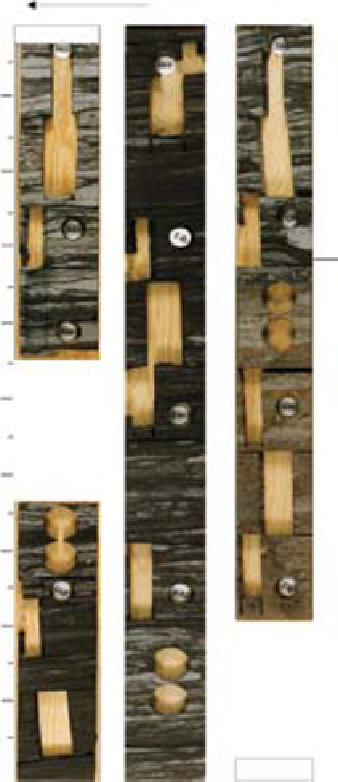Geoscience Reference
In-Depth Information
moderate and dominated by sediment-feeding
structures from transitional to inner-neritic zones
of the
Cruziana
Ichnofacies, alternating with a
mixed
Cruziana-Skolithos
suite. The heterolithic
deposits are commonly overlain by sharp-based
very fine to fine-grained sandstone (F4) showing
negligible bioturbation and large-scale HCS
capped by wave ripples and/or wave-generated
fluid-mud deposits (Ichaso & Dalrymple, 2009).
These deposits are interpreted as proximal
episodic tempestites, indicating temporary high-
energy oscillatory energy that deposited the event
bed and created the high-density suspension that
formed the capping fluid-mud layer (cf. Traykovski
et al
., 2000). Alternation of moderately biotur-
bated intervals with weakly bioturbated intervals
(associated with HCS beds) suggest fair-weather
(inter-storm) periods interrupted by episodic
storm events. The wave-dominated heterolithic
nature of these deposits and their sandier-upward
organisation, coupled with the trace-fossil assem-
blages and the lack of channelised facies, suggest
that FA6 was deposited in the proximal portion of
the delta-front area.
sanding upward
100
Top
90
80
70
60
50
40
30
20
Facies association 7 (FA7): Distal
wave-influenced delta front
10
FA7 consists dominantly of mixed sandstone-
mudstone heterolithics that commonly are
arranged in stacked coarsening-upward and sand-
ing-upward successions. Sharp-based combined-
flow heterolithics (F5.2.2) show a dominance of
wave-generated structures (e.g. wave ripples and
small-scale HCS) and low levels of bioturbation
dominated by deposit feeders. These deposits
alternate with disturbed heterolithics (F6.3) and
are overlain locally by light grey homogenised
sandstones (F6.4) showing mixed
Cruziana-
Skolithos
suites. Locally, erosively based medium-
grained to fine-grained cross-bedded sandstone
beds (up to 30 cm thick) alternate with the biotur-
bated intervals. The dominance of wave-generated
structures suggest moderate to high oscillatory-
current energy levels. Obvious tidal indicators are
absent or are not preserved due to the degree of
bioturbation. Bimodal bioturbation degrees (low
and intense) and the local presence of cross-
bedded sandstones are indicative of seasonality
(similar to FA3 and FA4). The overall presence of
wave and combined-flow sedimentary structures
and the vertical organisation of facies suggest dep-
osition in a wave-influenced delta-front setting.
Base
0 cm
Fig. 14.
Facies association FA5: Proximal prodelta deposits
composed of thick pinstripe-laminated mudstones and
mud-dominated heterolithics that become sandier upward
to very fine-grained mixed sandstone-mudstone heterolith-
ics showing ripple cross-lamination (locally bipolar). These
deposits locally overlie thick reworked marginal-marine
lags (FA2). Example taken from reservoir zone Tilje 2 (T2).
Facies association 6 (FA6): Storm-influenced
delta front
FA6 (Fig. 15) is overall mixed sand-mud domi-
nated and bedding generally thickens and becomes
sandier upward. Lenticularly-bedded mudstone-
dominated heterolithics (F5.3.1) are commonly
overlain by mixed sandstone/mudstone hetero-
lithics (F5.2.1 and F5.2.2). The pervasive presence
of symmetric and combined-flow ripples and
small-scale HCS, indicate moderate levels of oscil-
latory and combined-flow energy. Locally pre-
served bipolar current-ripple cross-lamination
suggests a tidal influence. Bioturbation is low to

Search WWH ::

Custom Search